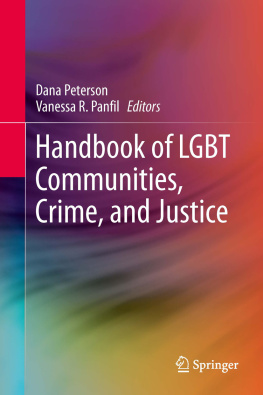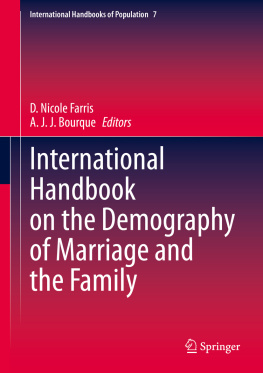1. Introduction: Balancing Connectedness and Autonomy in Diverse Families
Balancing Connectedness and Autonomy in Diverse Families
Before describing the history, purpose, and structure of this book, it seems appropriate to identify an unintentional and latent theme in this Handbook of Marriage and the Family, 3rd Edition . As we edited these excellent chapters, a covert theme seemed to emerge in this immense amount of knowledge that explains why people seek to live in the diversity of family forms and close relationships described in this book. An essential theme that courses through these pages is that families, in their various forms, may be the primary means to address two fundamental interpersonal relationship needs: connection and autonomy. Reduced to their essence, family members, following the human inclination for social bonding, seek to address the elemental relationship question: How to balance ones needs for connections with others while, at the same time, affirming ones individuality within their interpersonal relationships? In a metaphoric sense, therefore, like birds, humans may need both a nest for secure connections as well as wings to soar freely and affirm their individuality within their everyday relationships. Much like birds, who build a great variety of nests for secure togetherness and have greatly varied flight capabilities, family members must manage this dynamic between togetherness and individuality in ways that fit their unique ecological and cultural circumstances (Raef, ).
The increasingly diverse forms of family relationships demonstrated in these chapters may be a primary means through which most of the humanity seeks to address these basic social needs. This analogy underscores the importance of balancing both the need to be secure or connected with others, while simultaneously gaining autonomy within marital, premarital, partnership, heterosexual, same sex, parentchild, and close family relationships of all varieties (Peterson, ). Given the great diversity of human circumstances and almost infinite individual uniqueness, many family forms or close interpersonal relations are needed for family members to both seek and realize the desired balance between being connected to others and autonomous enough to affirm ones individuality. As these chapters will illustrate in a multitude of ways, families continue to develop novel structures and processes so they can satisfy needs for establishing connections with each other while, at the same time, practicing autonomy in creative ways so they can adapt to changing social, cultural, historical, and economic circumstances.
An initial understanding of the importance of finding an acceptable balance in autonomy and connectedness in family relationships first requires clear descriptions of what is meant by these two concepts. The first of these dimensions, connectedness in family relationships, is an aspect of intimate relationships that is shaped by a complex of general social values and qualities frequently referred to as collectivism (Kagitcibasi, ).
The second of these concepts, autonomy, is an aspect of intimate human relationships that is closely allied with a complex of general social values and qualities often referred to as individualism . As an aspect of individualism, autonomy has been the most prominent theme among American immigrant groups from Western Europe and has been the dominant theme throughout the United States history (Bellah, Madsen, Sullivan, Swidler, & Tipton, ). Diverse family forms and close relationships vary extensively in the degree of autonomy that is encouraged or tolerated. In short, having sufficient autonomy within diverse families allows their members the flexibility to make choices about whether or not to cooperate with group expectations, chart a unique response that affirms ones individuality, or choose some pathway in-between these options. The result is that family and relationship diversity provides an increasing degree of choice about how to achieve the desired balance between the goals of expressing ones individuality and being connected to others.
Some initial caution is necessary, however, when characterizing family systems and their encompassing cultures as either collectivistic or individualistic, when most, in fact, are neither exclusively one or the other (Kagitcibasi, ). Thus, for example, expressions of family connection may differ both across two predominantly collectivistic ethnicities as well as between collectivistic and individualistic communities. An illustration is the tendency of collectivistic Chinese American family members to use physical affection (e.g., hugging, kissing, etc.an aspect of connection) less often than is common for the collectivistic practices of Hispanic American family members.
Despite the centrality of this dynamic between autonomy and connectedness in family relationships, disparate views exist about whether states of tension or compatibility are most often prevalent between autonomy and connectedness. The initial, and until recently, the most prominent viewpoint was to portray the relationship between autonomy and connectedness as one of conflict or tension. A tension viewpoint portrays the quest for autonomy as a set of psychological attributes and behaviors aimed at guiding a person to separate or disengage from primary social connections in favor of pursuing ones own self-exploration and self-interest. Such a conception almost inevitably means that relationship connectedness, which emphasizes affiliation, nurturance, responsibility, conformity and engagement, must be at odds with autonomy. From this tension perspective, autonomy and connectedness often are viewed as opposing forces in which any increases in one will inherently lead to decreases in the other, much like a zero sum game (Peterson, ).
Such conceptions of tension are evident, for example, in popular conceptions of adolescent development in families where this dichotomy is presumed to exist and prevent continued conformity to their parents expectations while the young are gaining independence from them (Peterson, ).
A tension viewpoint portrays adolescents as achieving autonomy through a distancing process as they spend less time with and reduce the quality of ties they have with parents. Gaining autonomy through separation provides the young with greater freedom from the physical and emotional controls of parents so they can make their own life decisions and engage in intimate relationships with people outside their families (Blos, ).
More recent interpretations of this tension or separation process, however, view it either as a declining perspective or one where mounting separation is not a developmental asset but a liability leading to growing delinquency, relationship dissatisfaction, dysfunction, social rejection, conflict, and dissolution of family relationships (Peterson, ). That is, parentchild relationships change in how autonomy and connectedness are expressed across the life course, but balance is still achievable when a secure base exists.
Contrasting with the tension perspective is the more recent view that autonomy and connectedness develop simultaneously as either universal or highly generalized aspects of human and family relationships. Some degree of balance between autonomy and connectedness is necessary because humans are believed, almost universally, to both assert their individuality at the same time they seek social connections with others instead of being at odds with each other. Autonomy and connectedness are multi-faceted aspects of family relationships that are compatible in ways that are virtually essential. Although the meaning of autonomy and connectedness may vary across particular relationship circumstances and cultures, both are thought to be present in interrelated fashion, in most, if not all cultural and family circumstances (Kagitcibasi, ).













